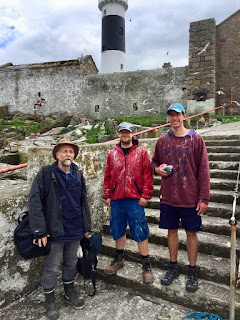It’s been a
busy time here on The Rock this past month with the vast majority of eggs
having now hatched. We’ve seen the eggs here tern from chick to fledgling in
what seems like no time at all as we wardens have been scrambling to try keep
up with the big peaks in synchronised laying and hatching that happen. The
chicks go through dramatic changes here in a very short space of time (30
days). In this blog I wanted to try show how striking a transformation these birds make so quickly.

The fluff ball stage lasts for about a week and then they begin transitioning to growing pins. This common tern chick is around 7 days old at this point has started growing their pins, the narrow tube like structures from which their very first set of feathers will emerge from. At this stage they have become quite mobile and start venturing all over the place away from their original nest site to any decent shelter or hiding place. Though venturing around the place comes with its own dangers as they can be pecked by other adults who are usually none too pleased to see these curious chicks that aren't theirs roaming around their nests and chicks.
Here is a
fully fledged Roseate Tern, and this folks is what Rockabill is all about. If
these young chicks can survive all the way through the trials and tribulations
of early life where they must run the gauntlet of survival, persevering against
food scarcity, exposure to wind, rain and being chilled to death and not to
mention predation; they eventually take their place out on the rocks amongst the
pantheon of great ones (i.e. the ones who survived) near the pools where there
parents bathe, preen and sun themselves. At this point they’re capable of
flying quite well but still not the best flyers just yet and many end up flying off and ending up in the surf to have to paddle back to the rocks and dry off before making anymore premature flight attempts. They’re also still reliant
on their parents for food still quite some time, as the art of fishing remains
a mystery to them for quite some time yet.





















